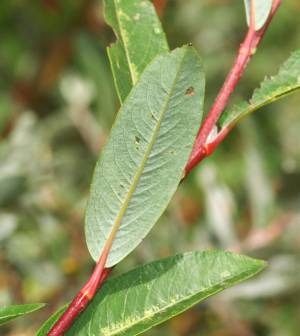Dr Phil Smith’s Wildlife Notes
November 2007
Always reluctant to give up plant-hunting as the autumn progresses, I spent the first half of November recording hybrid willows on the sand-dunes. “Get a life” I hear you say, but actually willows are one of the most interesting groups of plants on the Sefton Coast. We have around 30 different kinds compared with about 26 lowland willows in the whole of Cumbria, a county said to be particularly rich in these trees and shrubs.
Willows are well known for their promiscuity, producing lots of hybrids that can be a challenge to identify, several of them being very rare. In total, we have four nationally rare hybrids in the sand-dunes, all involving the abundant Creeping Willow (Salix repens) as one of the parents. The rarest of the lot, found in only about six places in the British Isles, is Salix x doniana (no English name), which is Creeping Willow crossed with Purple Willow (Salix purpurea). I was very pleased to find two new bushes at Lifeboat Road, one at Cabin Hill and nine at Hightown dunes to add to the ten or so already known for the coast. The hybrids keep their leaves longer than the parents, so they become easier to spot amongst the dense stands of Creeping Willow. Doniana is a particularly attractive small shrub with bright red stems, bluish leaves that turn yellow in autumn and red-tinged catkins in spring. It would make quite a decorative garden plant.

Bird-watching tends to replace botany in the winter. At this season we see lots of species from Arctic breeding areas, such as the 1400 Common Scoters and 45 Red-throated Divers counted on the sea off Formby Point on 12th November. A Pale-belled Brent Goose from northern Canada was spotted on Birkdale shore and a Little Auk, perhaps originating in Spitsbergen, was picked up dead at Crosby Marina, while up to six Snow Buntings were an attraction on Ainsdale beach.
Derek Forshaw tells me the “Lancashire” goose count on 11th November totalled 38,478 Pinkfeet, the third highest November total. On the mosslands east of Formby, large flocks can often be watched at fairly close-range using a car as a hide. But these wary birds, hunted over most of their range, will not tolerate a person on foot within several hundred yards, so it is important to stay in the vehicle. A particular skill is to find the occasional fellow-traveller with the Pinkfeet. I searched a flock of about 4000 geese at Downholland Moss on 17th November but failed to find a Tundra Bean Goose from Siberia reported with the same flock that day. In my defence, Bean Geese are hard to spot, their plumage being very similar to a Pinkfoot. They have orange legs, often hidden in the vegetation, and an orange band on the bill instead of a pink one. Derek reported a Ross’s Goose with Pinkfeet on Plex Moss on 11th November. Being mostly white, this species is not going to be missed but it is more likely to be an escape from captivity than a truly wild bird from the Canadian Arctic.

Feeding garden birds is a popular pastime in winter and can help them get through a cold snap, not that we have many of those these days. I was reminded how mild the autumn has been so far by hearing a Song Thrush in full song just outside my window while writing these notes on 26th November.
The new “Birds of Lancashire” book is soon going to print.
